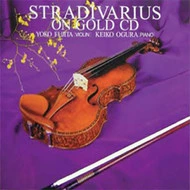Newly Recut & Remastered by Kevin Gray for this Limited Edition 24 Karat Gold CD!
"One of the Best Sounding Classical CDs Ever Made! Highly Recommended!" - Bob Bantz, president of Elusive Disc
 Click Here for Sound Samples!
Click Here for Sound Samples!
One of the world's greatest violin records is back on 24 Karat Gold CD and better than ever! Newly Recut & Remastered by Kevin Gray, with improved liner notes, new packaging and new photographs.
Experience the multi-faceted tonal brilliance of music's most sublime instrument in stunningly life-like sound. Stradivarius On Gold features Yoko Fujita on the Strad and Keiko Ogura on piano. The instrument is believed to be one of the first of specially commissioned, decorative violins and is named "Sunrise" and produces the sweetest tones imaginable. Impex's limited edition Stradivarius on Gold CD features timeless violin classics from Mozart, Beethoven, Massenet and others.
The Sunrise Stradivarius Violin:
Through the courtesy of Mr. Michio Fujii, the current owner of "Sunrise"- the most exquisite instrument among all Stradivari - it has been transformed onto CD to commemorate the 250th anniversary of the demise of Stradivari by the performance of the talented violinist Yoko Fujita. Ordinarily, "Sunrise" is stored in a room at ambient temperature and humidity. To make "Sunrise" perform in a lively and robust fashion, Ms. Fujita, who had just returned from West Germany, literally had to "warm it up" for one month. A special feature of this instrument is that external influences such as the acoustics of a room, the humidity in the hall and the sensitivity of the musician can cause its tenor to change, creating variations of its performance which may be many times greater than ordinary violins. Moreover, this instrument seems to have a peculiar tonality. If force is applied excessively by the artist, it sounds awkward and if force is exerted too gently, the sound is not produced at all. These features form the "miracle of Sunrise" as it lets people [when played well] hear its wonderful acoustics.
Selection of The Hall:
The essential objective in recording the "Sunrise" is first and foremost to catch its natural tonal color. With this point in mind, a careful selection of hall and microphones was made. Very few adjustments are needed to record violin and piano in this case and moreover, they do not require a large hall. Natural acoustics should be given more attention. Hence, the Verio Hall located at Hongo in Tokyo was selected. A certain feature of this hall was that reverbations could freely controlled. After sufficient rehearsal, the session was arranged so that the best acoustics of "Sunrise" reflecting its inherent sonic nature could be reproduced. Depending on the pieces, reverberations had to be fine tuned.
Microphone Selection:
Neumann microphones were primarily used. The piano was recorded with two U87s and the "Sunrise" received one U67. For Beethoven's "Spring Sonata", a Schoepps CMC 56U were used. Mic selection was not based on a subjective "superior" or "inferior" quality, but rather the variation of tonal color generated when used on each instrument. Two B&K 4006s were used to record the on-stage hall ambiance.
Recording Technique:
The multi-mono recording method which would display innacurate imaging behavior was avoided. Efforts were made to produce the richness, acoustics and naturalness of Verio Hall's character. Moreover, the blending of violin and piano acoustics were taken into consideration during the recording process. In order to achieve this, a non-equalized method was selected. Microphone output was fed into a modulator and then directly sent to the recording system. This was done to avoid the need for artificial processing during mixdown. Only the sub-harmonic frequencies in the ambience microphones (which were placed on stage in front of the violin and piano) were filtered and random noises made during were recording were filtered. All other signals were recorded "flat." By doing so, microphone placement played a much more important role, with many small position adjustments made depending on the piece of music played. Moreover, in order to highlight the stage's ambiance, items that would obstruct this were carefully removed. The violin was placed slightly right of center and the piano was placed slightly left of center on the stage... Music Worthy Of The "Sunrise."
Why Buy a Gold CD?
Aluminum particles are rough, resulting in pits and irregularities on the playing surface. Gold particles are uniform and have a constant rate of reflection giving an even, reproductive sound quality. Gold plated discs will not oxidize or tarnish and will last for years. More precise playback, higher transfer rate from analog master, higher and lower frequency limits, extended dynamic range across all frequencies without the need of added equalization... The Golden Pinnacle of CD Playback!
Features:
Newly Recut & Remastered by Kevin Gray for 2011
Limited Edition
24K Gold CD
Musicians:
Yoko Fujita, violin
Keiko Ogura, piano


"One of the Best Sounding Classical CDs Ever Made! Highly Recommended!" - Bob Bantz, president of Elusive Disc
 Click Here for Sound Samples!
Click Here for Sound Samples! One of the world's greatest violin records is back on 24 Karat Gold CD and better than ever! Newly Recut & Remastered by Kevin Gray, with improved liner notes, new packaging and new photographs.
Experience the multi-faceted tonal brilliance of music's most sublime instrument in stunningly life-like sound. Stradivarius On Gold features Yoko Fujita on the Strad and Keiko Ogura on piano. The instrument is believed to be one of the first of specially commissioned, decorative violins and is named "Sunrise" and produces the sweetest tones imaginable. Impex's limited edition Stradivarius on Gold CD features timeless violin classics from Mozart, Beethoven, Massenet and others.
The Sunrise Stradivarius Violin:
Through the courtesy of Mr. Michio Fujii, the current owner of "Sunrise"- the most exquisite instrument among all Stradivari - it has been transformed onto CD to commemorate the 250th anniversary of the demise of Stradivari by the performance of the talented violinist Yoko Fujita. Ordinarily, "Sunrise" is stored in a room at ambient temperature and humidity. To make "Sunrise" perform in a lively and robust fashion, Ms. Fujita, who had just returned from West Germany, literally had to "warm it up" for one month. A special feature of this instrument is that external influences such as the acoustics of a room, the humidity in the hall and the sensitivity of the musician can cause its tenor to change, creating variations of its performance which may be many times greater than ordinary violins. Moreover, this instrument seems to have a peculiar tonality. If force is applied excessively by the artist, it sounds awkward and if force is exerted too gently, the sound is not produced at all. These features form the "miracle of Sunrise" as it lets people [when played well] hear its wonderful acoustics.
Selection of The Hall:
The essential objective in recording the "Sunrise" is first and foremost to catch its natural tonal color. With this point in mind, a careful selection of hall and microphones was made. Very few adjustments are needed to record violin and piano in this case and moreover, they do not require a large hall. Natural acoustics should be given more attention. Hence, the Verio Hall located at Hongo in Tokyo was selected. A certain feature of this hall was that reverbations could freely controlled. After sufficient rehearsal, the session was arranged so that the best acoustics of "Sunrise" reflecting its inherent sonic nature could be reproduced. Depending on the pieces, reverberations had to be fine tuned.
Microphone Selection:
Neumann microphones were primarily used. The piano was recorded with two U87s and the "Sunrise" received one U67. For Beethoven's "Spring Sonata", a Schoepps CMC 56U were used. Mic selection was not based on a subjective "superior" or "inferior" quality, but rather the variation of tonal color generated when used on each instrument. Two B&K 4006s were used to record the on-stage hall ambiance.
Recording Technique:
The multi-mono recording method which would display innacurate imaging behavior was avoided. Efforts were made to produce the richness, acoustics and naturalness of Verio Hall's character. Moreover, the blending of violin and piano acoustics were taken into consideration during the recording process. In order to achieve this, a non-equalized method was selected. Microphone output was fed into a modulator and then directly sent to the recording system. This was done to avoid the need for artificial processing during mixdown. Only the sub-harmonic frequencies in the ambience microphones (which were placed on stage in front of the violin and piano) were filtered and random noises made during were recording were filtered. All other signals were recorded "flat." By doing so, microphone placement played a much more important role, with many small position adjustments made depending on the piece of music played. Moreover, in order to highlight the stage's ambiance, items that would obstruct this were carefully removed. The violin was placed slightly right of center and the piano was placed slightly left of center on the stage... Music Worthy Of The "Sunrise."
Why Buy a Gold CD?
Aluminum particles are rough, resulting in pits and irregularities on the playing surface. Gold particles are uniform and have a constant rate of reflection giving an even, reproductive sound quality. Gold plated discs will not oxidize or tarnish and will last for years. More precise playback, higher transfer rate from analog master, higher and lower frequency limits, extended dynamic range across all frequencies without the need of added equalization... The Golden Pinnacle of CD Playback!
Features:
Newly Recut & Remastered by Kevin Gray for 2011
Limited Edition
24K Gold CD
Musicians:
Yoko Fujita, violin
Keiko Ogura, piano

 Turntable Accessories
Turntable Accessories Headphone Accessories
Headphone Accessories Cable Accessories
Cable Accessories Vinyl Accessories
Vinyl Accessories Compact Disc Accessories
Compact Disc Accessories







